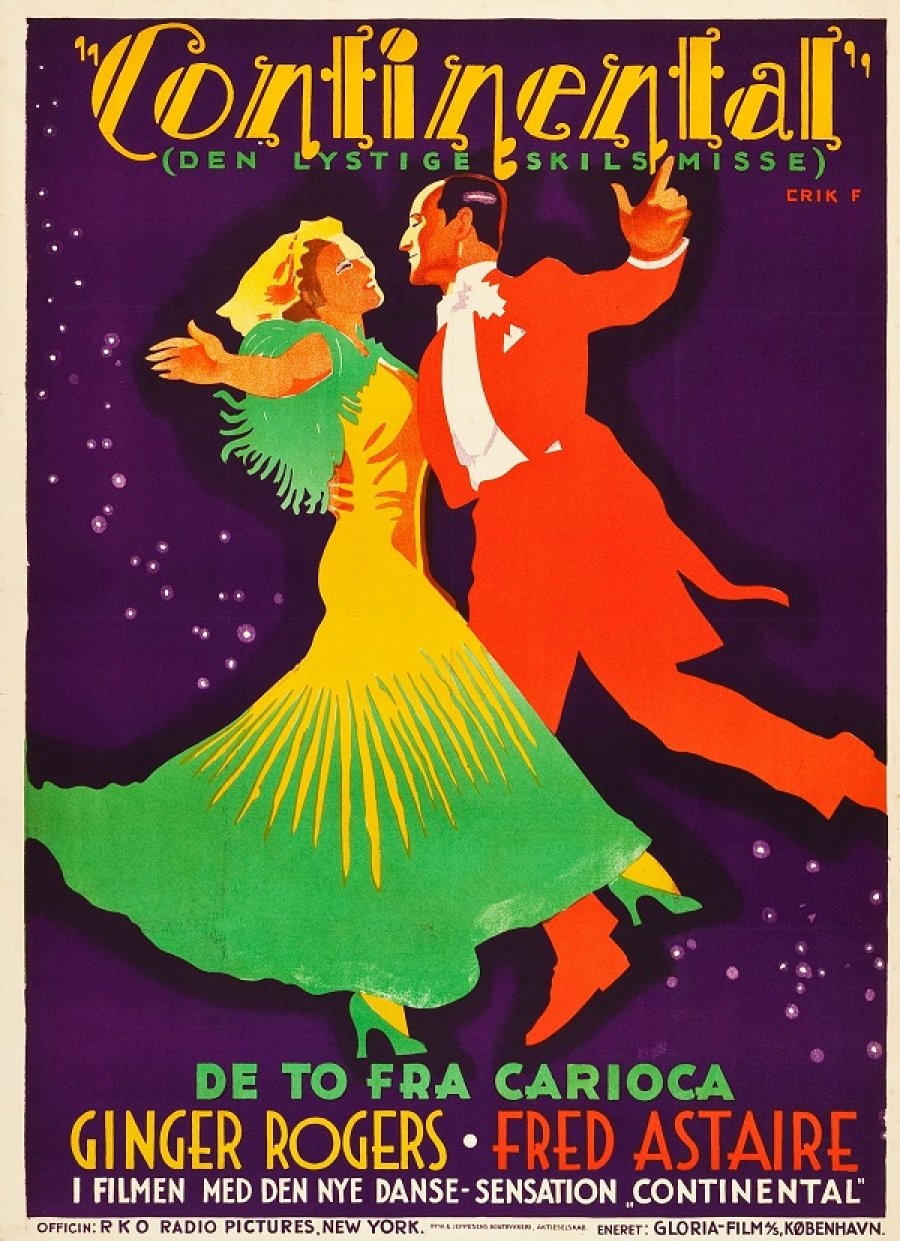Displaying items by tag: thomas dimopoulos
Art of the Dance: Posters from Hollywood’s Golden Age Coming to the National Museum of Dance
SARATOGA SPRINGS – Fred Astaire trips the light fantastic with Ginger Rogers on a dayglo brilliance that emanates across the frame. A pensive Snow White, encircled by a half-dozen dwarfs, hovers atop a Russian banner as the Evil Queen ominously glares from the shadows. Here is Lucille Ball exuding a technicolor presence in announcing MGM’s Ziegfield Follies in 1945. There, is “The Sound of Music” from Germany, “Dirty Dancing” from Poland, and Clark Gable in “Dancing Lady,” a promotion that comes from Belgium.
“I’ve always been fascinated by posters from this period,” says Mike Kaplan, who has collected vintage movie posters for several decades.
“The key to collecting the vintage ones began in the late ‘70s when I went to a store called Chic-A-Boom, a memorabilia shop on Melrose,” Kaplan recalls. “There was a stack of movie posters against the wall. The first one was “Irish Eyes Are Smiling," a musical from the ‘40s and it had a full-length still photography image of June Haver, who I had a crush on as a teenager. So, I bought that one and in a way that began the second phase of the collection.”
Kaplan estimates he has 3,000 to 4,000 posters in his collection. More than 100 will be displayed in Saratoga at The National Museum of Dance at the exhibition “Art of the Dance: Posters from Hollywood’s Golden Age from The Mike Kaplan Collection.” The exhibit will open May 10, a date that also marks what would have been Fred Astaire's 120th birthday.
“The great thing about the posters is people will be exposed to artwork from so many different countries interpreting American movies in different ways - so you get completely different interpretations of a movie from France or Italy, Germany or Japan,” says Kaplan, who grew up in Providence, Rhode Island. “There is also the size of the posters. They vary from country-to-country. People walk in and for the most part their jaws drop seeing the imagery, the size and the amount of care that went into the artwork.”
More than 100 dance movie posters will be mounted in three of the Museum's galleries. The posters range in date from 1918 to the 1980s with the majority representing the 1930s, 40s, and 50s.
Kaplan was 9 or 10 years old when his family vacationed in the Saratoga region. Today, he makes his home in Idaho. He has penned a pair of books -– “Gotta Dance,” and “Gotta Dance Too!” - depicting the posters and their history. During the 1960s, he worked as marketing strategist on two iconic Stanley Kubrick films.
“With 2001 (A Space Odyssey), I was working at MGM as a publicist. I don’t think people remember this, but the film was not well-received initially. It wasn’t positioned properly. People were expecting some kind of traditional science fiction movie; instead it was this contemplative, metaphysical journey into time. The audience and the critics weren’t prepared for it. It threw people, but I just loved the movie. I thought it was one of the best films ever made and I still feel that way,” Kaplan says.
“With ‘Clockwork Orange,’ I wanted everything to be perfect so there wasn’t any misinterpretation of the movie and having everything choreographed out to the nth degree – which Stanley appreciated and loved doing because he was such a perfectionist. So, we got on very well. Kubrick was just a great artist and whatever he touched was of importance. There was just a phenomenal response to it,” Kaplan said.
Selections of the posters have been on view in major venues such as Lincoln Center and the Los Angeles County Museum of Art. Art of the Dance at the National Museum of Dance will be the largest and longest installation of this collection to date, on view until spring 2020.
In addition to Astaire, several major dance and musical stars from the 20th century are highlighted such as Gene Kelly, Ginger Rogers, Shirley Temple, and The Nicholas Brothers.
The opening reception for Art of the Dance: Posters from Hollywood’s Golden Age will take place on Friday, May 10 at 7:00 pm. The cost is $10 per person and free for members. The National Museum of Dance is located at 99 South Broadway. For more information, 518-584-2225, or go to: www.dancemuseum.org.
Laurie Anderson brings A Life of Storytelling to Saratoga Springs
SARATOGA SPRINGS – Touching upon themes of the Tibetan Book of the Dead, her love of dogs, her disdain for pop culture and a human planetary existence altered in dramatic ways due to a changing climate, artist/composer/musician and film director addressed a large crowd gathered inside the Tang Museum’s Payne Room where she told them, apocalyptic visions aside, her focus is: How Best To Tell The Story.
“The world is made of stories. Our own stories. Other people’s stories, (so) how do you tell a story like that, where, you know, this is going end?” Anderson said. “We’re the first people in the history of the human race who can see our own extinction coming. The first ones. Stories are things that are told to others but in this case, this is a story that’s told to no one. The first story that is: Told. To. No one.”
Anderson’s appearance April 17 was the night two feature of the Tang Museum’s three-day Bardo Now series. George Saunders, author of the 2017 novel “Lincoln in the Bardo,” appeared via video chat on night one, in conversation with Donald S. Lopez, Jr., professor of Buddhist and Tibetan Studies at the University of Michigan and author of “The Tibetan Book of the Dead: A Biography.”
The series’ closing night featured a concert by guitarist Tashi Dorji and percussionist Susie Ibarra, performing an experimental duet conceived for the event as a musical bardo exploration.
The 90-minute presentation showcasing Anderson, a practicing Buddhist, was staged as an “in conversation” event with Benjamin Bogin, the director of the Asian Studies Program at Skidmore College.
“It’s the living bardo that’s thrilling to me,” said Anderson, when asked to connect Tibetan Buddhist themes with her creativity. “As a musician, I think the way I can most experience what you would call a bardo is in just this moment - because you don’t know what you’re going to play next,” said Anderson, noting that she doesn’t subscribe to the standard narrative form of beginning, middle and end. “That seems artificial to me. The fractured story is what I do. I respond to work where we don’t really quite know what we’re doing and what will happen next. That’s also why I’m also drawn to virtual reality. You’re making it up as you go along.
“When I first began to (improvise), I felt this incredible sense of freedom in not knowing what was going to come next, in responding to another person in a way that was absolutely in that moment - not in some other moment that you thought might be interesting - but right now. That was a big, big thrill to me as a musician.”
Anderson screened an 11-minute segment from “Heart of a Dog,” her 2015 documentary which centers on Anderson's remembrances of her late beloved dog Lolabelle, and concludes with an image of husband Lou Reed, who died in 2013.
“It was a film where my dog died – that was the core of it – but it was really dedicated to my teacher, Mingyur Rinpoche. One of the things I treasure about his teachings is his clarity, things like: it’s really important to practice how to feel sad, without being sad - and that distinction is a very important one because there are many, many sad things in the world and if you try to push them away, or pretend they’re not there, you’re an idiot! They will find you and they will get you,” she explained. “So, (Rinpoche’s) idea is: do not become that yourself.”
Professor Bogin said he was struck by the film’s exploration “visually, sonically and poetically,” of bardo ideas, as Anderson narrated a series of paintings used in the film depicting Lolabelle’s journey through the 49 days of the bardo, “how memory starts flooding through the mind and you’re suddenly every single being that you’ve ever been in your life; the many beings that you are, simultaneously.
“I think for most people who experience death, what an incredible privilege it is that that door opens…you get this chance to really look at it and feel it,” Anderson said. “I think sometimes experiencing time and death and love is sometimes easier when you look at what happens with animals and what the effects have on those creatures. You get that in a more immediate way.”
Anderson became a reluctant musical hit-maker in the early 1980s when her song “O Superman” climbed to no. 2 in the UK Pop charts alongside the likes of Rod Stewart, Elvis Costello, and The Police. It was a record she made on a $500 NEA grant in 1980.
“Anytime somebody said, ‘I want a copy of your record,’ I would walk it over to the post office. One day someone called, they spoke with a British accent, and they said: we need some copies of your record. I said, ‘OK, how many?’ They said: 40,000. by Monday. And another 40,000 by Wednesday. I’ll. Get. Right. Back to you,” Anderson recalled.
“So, I called up Warner Bros. Records – they’d been coming to my shows and saying: don’t you want to make a record? I said, no, not really. But, I called them up and said: you know that record you wanted? Can you make a bunch of them really soon? And they said: well, that’s not the way we do things at Warner Bros Records and Tapes. We’ll sign an eight-record deal. What?
“I got a lot of criticism from artists, for ‘selling out.’ A couple of months later, it was called ‘Crossing Over.’ And everyone wanted to do it.”
The song, based on a prayer by French composer Jules Massenet is about the power of technology, and of loss, Anderson said. “Technology doesn’t save you. If you think technology is going to solve your problems, you don’t understand technology - and you don’t understand your problems,” she said.
“It was really about the moment when we were going to go in and rescue the hostages. And America was going to go in and pull them out and American technology was going to shine. Then the helicopters crashed and burned in the desert,” she said, regarding the ill-fated military rescue attempt in April, 1980.
While that international success of the record made it easier for Anderson to create other things, she warns there is also a danger
“Pop Culture,” she says with disdain. “What happened? Corporate America has entered culture. It’s disturbing to me, because it’s Culture Light. It’s America’s Got Talent culture. Nothing wrong with that except when they come into your neighborhood and go: we love the community you built and now we’re going to buy it, we’re going to brand it, and sell it back to you. And we’re going to curate it while we’re at it and say what’s important and what is not.
“We have to think about what we’re making. Now, often you see it’s just about the box office -how many people get through the doors – and it doesn’t really matter what the experience is. I do think that there’s art for everybody – but it’s a tricky thing, to make sure that it’s not just so watered down that it’s just feel-good stuff.”
The Frances Young Tang Teaching Museum and Art Gallery is located on the campus of Skidmore College On exhibit through May 19: The Second Buddha: Master of Time presents the story of the legendary Indian Buddhist master Padmasambhava - widely credited with bringing Buddhism to the Tibetan lands. The exhibit features Tibetan scroll paintings (thangkas), textiles, and manuscripts from the 13th through 19th centuries.
Songpoet Legend: Eric Andersen Performs at Caffe Lena Sunday
SARATOGA SPRINGS – It was shortly before the Summer of Love, just before the Monterey Pop Festival in June 1967 and around the time Muhammad Ali was stripped of his boxing world championship for refusing to be inducted into the U.S. Army.
Eric Andersen, by that time, already had a couple of albums to his credit. He’d made an appearance in an Andy Warhol film alongside “Girl of the Year" Edie Sedgwick, and was being recruited by Brian Epstein to be taken under the Beatles’ manager’s wing. Epstein arrived in New York with an advance copy of “Sgt. Pepper's Lonely Hearts Club Band,” and invited Andersen to give it a preview listen.
“He had just flown over from London and was at the Waldorf Astoria,” Andersen recalls. “We had a little record player and he just played it. We heard ‘A Day In The Life.’ We heard a bunch of tracks, there, in the dark, with only a little light coming from the bathroom that was open just a crack.”
Three years later, Andersen journeyed alongside Janis Joplin and the Grateful Dead atop the rails of their legendary trans-Canadian train tour, and a handful of years after that was on stage harmonizing with Patti Smith in a prequel to Bob Dylan's equally legendary Rolling Thunder Revue. Legendary status finds him resting easily.
“Live long enough and you’ll get to meet everybody,” he says with a laugh.
Fast-forward to the present day where on an early spring afternoon, the singer-songwriter-poet is motoring between a booking in Philadelphia – where he sang about Lou Reed in Anthony DeCurtis' music journalism class – and Montclair, New Jersey, where a 1960s themed concert is being staged. Over the past two weeks, he’s appeared in Greece to give a speech to a psychoanalytic convention – “I know, go figure,” – and celebrated Lawrence Ferlinghetti's 100th birthday on the Lower East Side alongside Anne Waldman, Ed Sanders and Laurie Anderson.
Now, he begins a springtime tour, which visits Caffe Lena in Saratoga Springs on Sunday, April 7. Andersen will be accompanied by percussionist Cheryl Prashker, producer, musician, and audio engineer extraordinaire Steve Addabbo, and violinist Scarlet Rivera - whose majestical bowing is forever sonically imprinted on the Bob Dylan tracks “Hurricane,” and “One More Cup of Coffee,” and on David Johansen’s “Lonely Tenement,” among others.
Twenty or so years ago, Andersen co-wrote a song titled "You Can't Relive the Past" with Lou Reed. And while maybe you can’t relive the past, he seems mostly OK talking about it, albeit amid all kinds of mayhem going on around him.
“We just missed an accident. Just got by it. Collision of two cars right on the street. Two firetrucks. Two ambulances. And a freight train going by overhead,” Andersen says. Further complicating matters is he is being navigated in a vehicle with an apparently wonky tire. “The car is vibrating,” he reports. Or, it could be the making of a song.
Born in Pittsburgh, Pennsylvania in 1943, Andersen received his early schooling in Buffalo, where he taught himself guitar and piano, watched Buddy Holly and the Everly Brothers play at his high school gym and saw Elvis Presley perform in a gold suit at the Buffalo Memorial Auditorium.
“What do you remember about Elvis in Buffalo in 1956?”
“When that first chord hit, the chairs were kicked away within one nanosecond and everyone was standing,” he responds.
In the early 1960s, Andersen hitchhiked west and landed at job at City Lights Bookstore in San Francisco, where he attended a party following a Haight-Ashbury poetry reading on a memorable November night in 1963. “I wrote a 26-minute-long tone poem called ‘Beat Avenue,’ about it,” he says. “The day John Kennedy was killed. I was at a party with Allen Ginsberg and Ferlinghetti, and (Kerouac’s friend) Neal Cassady – the protagonist of ‘On The Road.’ They were all there. And Allen was walking around with no clothes on. That was funny. Like a naked Buddha.” The double CD set, “Beat Avenue,” features 14 original compositions in all, and was released in 2003.
At the invitation of Tom Paxton, Andersen headed to New York City where a flourishing Greenwich Village songwriting circle included Phil Ochs, Dave Van Ronk, Bob Dylan and Ramblin’ Jack Elliott. His first New York gig was opening for John Lee Hooker. He performed at a plethora folk and jazz clubs. And when not performing, was watching others - the Velvet Underground, the Doors, and John Coltrane, among them – stage their own performances.
“John Coltrane… on stage he could put himself in a trance and play. And eventually he’d put you in a trance,” Andersen says.
During the 1970’s, Andersen divided his time between California and New York, the latter being where a new scene was unfolding with people like Sam Sheppard and Leonard Cohen, Robert Mapplethorpe and Patti Smith. “Patti Smith: she was working at the book store, and we were all living at The Chelsea Hotel.” Manhattan, meanwhile, isn’t what it used to be. “It’s so gentrified and expensive,” he says.
The early ‘70s also delivered the release of “Blue River,” perhaps his best-known and best-selling record. “One crazy (concert) was when my album ‘Blue River’ came out. I did a show with the Jefferson Airplane in front of 400,00 people. They had a band. I had a guitar. I mean, I figured if I didn’t get a heart attack that day… I’ll live forever.”
More recently, Sony/Legacy Recordings issued “The Essential Eric Andersen” last spring. The 42-track retrospective covers 50 years of Andersen’s recorded history. A retrospective documentary, titled “The Songpoet,” is slated for release later this year. (The trailer, which looks awesome, may be viewed HEREHERE.
On April 7, Andersen returns to Caffe Lena, where he last performed 12 months ago.
"Saratoga. If I had done better at the track, I could be living in my Range Rover on my small estate in Saratoga Springs, one of those houses with the pillars with a chandelier 100 miles up over the front door," he says with a laugh. Of Sarah Craig, Caffe Lena’s executive director, Andersen says: “she’s one of the most interesting people I’ve ever met. She’s a repository of arcana. She knows all kinds of facts and figures about the world; a reservoir of fascinating information,” he says. “You can print that for everybody to know.” So, there it is.
Eric Andersen, with Scarlet Rivera and Cheryl Prashker, performs 7 p.m. Sunday, April 7 at Caffe Lena, 47 Phila St., Saratoga Springs. Tickets are $35 general admission, $32 café members, $17.50 students and kids. More information and tickets, go to: caffelena.org, or call 518-583-0022.
Putnam Street Eyesore Demolished, Condos Planned
SARATOGA SPRINGS – An eyesore that stood for decades on Putnam Street was demolished Monday afternoon. In its place will rise a five-story mixed-use building with plans calling for a restaurant at the street level and approximately two-dozen condominium apartments upstairs.
“Everyone I know has loathed that building for decades,” said Jason Letts, shortly after a massive excavator, boasting more than 80,000 lbs. of operating weight, extended its 20-foot boom and clawed at the architecture, laying to waste the last wall standing and leaving a debris field comprised of twisted metal and broken bricks, splintered wood and chunks of concrete.
“Before I got involved with this, whenever I’d take my son to the library (across the street) I’d think: somebody’s got to do something about that, so I’m glad to be doing something about it,” said Letts, one of the co-owners of the proposed “Five-Three” development that will be located at 53 Putnam St., opposite the Saratoga Springs Public Library.
The initial intent was to revamp the existing two-story building and create a performance venue with a food service component. Those plans changed after the site was revealed to be contaminated from its earlier use as a dry clean facility as well as sustaining oil contamination from an offsite source.
“When we learned about all the environmental conditions, it wasn’t feasible,” Letts said. “The building had asbestos and was completely dilapidated. It had to go. The next step is removing five feet of soil, and also some oil.”
Environmental remediation is being conducted via the state’s Brownfield Cleanup Program –an alternative to greenfield development and intended to remove some of the barriers to, and provide tax incentives for, the redevelopment of urban brownfields.
Late in 2018, the group proposed the development of a six-story building featuring 40 condominium units in the $400,000 to $800,000 price range topped by a roof deck, pergola and a stair tower – which would top-off at 84 feet above ground-level.
Those plans have since been scaled back to a proposal of four floors and a partial “setback” fifth floor, Letts said. The number of condo units has also been amended to about 23 apartments in all. The price point will stay the same as initially proposed.
Earlier plans for a ground floor communal-type kitchen have also been amended and will instead likely feature a restaurant. Letts said there is strong interest from Capital Region based restaurants seeking to move into Saratoga.
The group is currently responding to some unresolved questions posed by the city’s Land Use boards, but the hope is that approvals will be secured in short order.
“We’re hoping to really get going in the fall. From that point, our construction manager is talking about an 18-month construction period,” Letts said. There are no plans for on-site parking. “That’s something we’re still working out,” he added. “We’re excited about making our city cleaner and more vibrant and we think this will be a big revitalization to some of the slightly off-Broadway areas.”
Greg Veitch Announces Retirement after 23 years with Saratoga Springs Police Department
SARATOGA SPRINGS – The Veitch name traces a path through city history that extends over several decades.
City Police Chief Greg Veitch’s great-grandfather’s generation were comprised of horsemen and jockeys, his grandfather serves as director of the city Urban Renewal Agency, and his dad was a schoolteacher in the Saratoga Springs School district for more than 30 years. A number of siblings, including Supervisor Matt Veitch, currently work for the city in a variety of departments.
For Greg Veitch, his career path was revealed to him one day as the teen sat in a local church.
“There was no law enforcement in my background, but like a lot of little boys, you grow up wanting to be a cowboy, a fireman, an army man,” Veitch recalls.
“I was 15 or 16 and sitting in St. Mary’s Church. The priest was quoting from Matthew,” he says. The verse that jumped out at him reads: Blessed are the peacemakers for they shall be called the children of God.
“That really clicked with me. When you’re 16 or so you want to be on God’s Team, you want to have an exciting life,” Veitch says. “That’s when it dawned on me: that’s what cops do. So, it’s really been a calling for me from that point on.”
Veitch began his law enforcement career in Burlington, Vermont where he worked just shy of a year before getting hired in his Saratoga Springs hometown in 1995. He moved through the ranks of the police department – from patrol officer and narcotics investigator to sergeant and was named chief of police in May 2013. The date is significant.
“Last year, I felt I was being called to do something else. I was on a Mission Trip to inner-city Miami and I started to get the feeling: hey, listen, you’ve got to do something other than what you’re doing.” Veitch expressed his thoughts to his wife, Jen, and May 31, 2019 was chosen as his retirement date from the Saratoga Springs Police Department. The date marks his six-year anniversary of his appointment chief.
Veitch plans to continue to teach criminal justice courses at SUNY Adirondack -which he has done the past five years, as well as instructing officers on a variety of topics at the regional Zone 5 Police Academy. In the fall, he plans to publish a follow-up book to his initial publication - “All the Law in the World Won't Stop Them,” featuring stories of criminals in the Saratoga Springs of yesteryear.
Veitch says he’s most proud of the police department. “The officers, the supervisors who every day go out and do the job they’re supposed to in an honorable way. I’m also proud of the relationships we’ve built with all the local enforcement agencies and the victims’ advocacy groups, because without good relationships it can be a disaster.”
He credits his colleagues, partners and mentors in law enforcement and the love and support of his family for providing him love and encouragement over his 23-year career.
Technology, says the chief, is the biggest change he’s witnessed over the decades, providing officers with rapid access to records and information. “Anyone in a job 20 or 30 years will see those types of changes. For us, I never would have thought that you would be recording yourself all the time,” he says of the body cameras with which that all city officers are equipped. “Not that I’m opposed to it. When I was starting out as an officer, I would have liked that.”
Chief Veitch’s retirement is effective May 31. Public Safety Commissioner Peter Martin will appoint a new police chief.
TV’s “American Pickers” to Film In New York, Seek Regional “Hidden Treasures”
Mike Wolfe, Frank Fritz, and their team return to New York in May when they plan to film episodes of the series American Pickers throughout the region.
The documentary series explores the fascinating world of antique “picking” on the History Channel and follows pickers Mike and Frank as they hunt for America’s most valuable antiques.
American Pickers is looking for leads to explore regional hidden treasures.
From the show’s casting associate producer: If you or someone you know has a large, private collection or accumulation of antiques that the Pickers can spend the better part of the day looking through, send us your name, phone number, location and description of the collection with photos to: This email address is being protected from spambots. You need JavaScript enabled to view it. or call 855-OLD-RUST.
Superfund, Super Mess, Super Headache
Soil Cleanup, Road Closure to Continue through June on Excelsior
SARATOGA SPRINGS — Construction work will continue through June in the Old Red Spring area on a stretch of Excelsior Avenue to address contaminated soil at the Niagara Mohawk Power Corporation Superfund site.
The project area comprises approximately 0.5 acres of land and includes the Old Red Spring well and pavilion and a portion of Excelsior Avenue north of the spring and part of a paved church parking lot west of the spring area.
The planned soil remediation will treat and contain tarry liquid located approximately 14 to 18 feet below the ground surface in the Old Red Spring area. The liquid migrated to the area via a former manufactured gas plant located nearby.
The Old Red Spring well – which will be retrofitted by adding a new protective steel outer casing - gets its water from a separate deep aquifer that has not been impacted by the coal tar or its associated chemical compounds, according to the United States Environmental Protection Agency. The EPA adds that Loughberry Lake - the source of drinking water for the city of Saratoga Springs, has not been impacted by contamination from the site either.
The work is being conducted by the Niagara Mohawk Power Corporation with oversight by the EPA, the New York State Department of Environmental Conservation, the New York State Department of Health, and the city of Saratoga Springs.
Excelsior Avenue will continue to be closed to vehicle through-traffic between Rock Street and High Rock Avenue during remedial construction.
City Engineer Timothy Wales said this week that the road will re-open in late June and in advance of the Firecracker 4 Road Race, which takes place July 4. Should all work not be completed by that time, the parties will return in the fall to complete the project, Wales said.
City Dems Endorse Five Candidates, Public Safety Primary: GOP Meets Tuesday Night
SARATOGA SPRINGS - The Saratoga Springs Democratic Committee announced its
candidate endorsements for city office in 2019.
The SSDC endorsed all four Democratic incumbents running for re-election: Meg Kelly, Mayor; Michele Madigan, Finance Commissioner; John Franck, Commissioner of Accounts; and Tara Gaston, County Supervisor.
The SSDC also voted to endorse one of its members, Dillon Moran, for Commissioner of Public Works. “Dillon’s engineering education, business background and close study of the City’s infrastructure and operations all form a solid basis for our support,” SSDC Chair Courtney DeLeonardis said, in a statement.
For Public Safety Commissioner, where the Democratic incumbent is not seeking re-election, the Committee decided not to endorse at this time.
“We heard from two strong, well-qualified candidates – Eileen Finneran and Kendall Hicks -- who each impressed Committee members,” DeLeonardis said. “Both individuals have a lot to offer the City. I believe Committee members, along with other supporters, will help both candidates qualify for the primary election in June, when voters will decide who runs for Public Safety Commissioner on the Democratic line in the fall.”
City Republicans will meet Tuesday and subsequently announce their endorsements for 2019, GOP chair Matt Hogan said Monday.
Primaries will take place June 25, and the General Election on Nov. 5. All five City Council seats and both city Supervisor seats are up for election this year.
"Dream Big": Japanese Resort Sets Sights on Saratoga
SARATOGA SPRINGS – An international resort company with a stated mission to “dream big” is eyeing the Spa City as a place to potentially develop its latest luxury hotel.
Hoshino Resorts, which operates 37 facilities both in and outside Japan, operates four distinct brands: luxury flagships, hot spring resorts, resort hotels, and city tourism hotels, featuring venues which vary from countrified mountainside resorts to the heart of big-city Tokyo. The company entered into a Memorandum of Agreement of Sale in September as purchaser regarding two parcels of land totaling nearly 87 acres, located just south of Saratoga Spa State Park. A “deed agreement” was filed with the Saratoga County Clerk’s Office on Oct. 3.
According to the company’s literature, Hoshino Resorts provides “a unique experience focused on the local charms of each destination and a high level of omotenashi Japanese-style hospitality.”
Hoshino Resorts was first established as a traditional Japanese inn in 1914. Today, the hotel management company is run by 4th-generation family member Yoshiharu Hoshino.
The company was formerly known as Hoshino Onsen Co., Ltd. and changed its name to Hoshino Resorts Inc. in 1995, and is based in Kitasaku, Japan, according to Bloomberg.com. An Albany-based attorney representing Hoshino Resorts did not return a phone message requesting information for this story.
The memorandum of agreement notes two specific parcels: 6.88 acres at Route 9 and Columbia Avenue, and 79.34 acres at 38 Columbia Avenue. The lands are located in a mostly wooded area, just south of the Saratoga Spa State Park and East West Road, just off Route 9. According to the document, the closing and transfer of title is slated to potentially take place within 30 days of the end of the due diligence period, specified as Nov. 1, 2020. Hoshino has the exclusive right to purchase the properties under the agreement.
Specific plans for the type of development under consideration for development in Saratoga Springs are not known.
Bradley Birge, the city’s administrator of planning and economic development, said formal applications that would signal the potential start of a project – such as a building permit - have yet to be filed with any of the city’s Land Use boards. Salomone and Company – a limited liability company with offices in New York City, is listed as the “seller” of the properties, according to the memorandum of agreement of sale.
Steven Salomone, whose grandfather Saverio Salomone purchased the property in the 1940s, was unable to confirm or deny anything relative to a potential transaction. He does remember visiting the property as a young man.
“When I was kid, we would go up there every summer,” recalled Steven Salomone, who is 64 years old. “I remember the State Park being next door. That was exciting to us. There is a small pond or lake on the property towards the back and when it would freeze, Saverio would go out and chop the ice and sell it. He was apparently running a pretty good business doing that,” Salomone says, with a laugh. “Back in the day people were still using ice boxes up there. I think they used to call it the Ice Lake.”
In 1949, Saverio was granted Zoning Board approval to erect six cabins off Columbia Ave., according to city records.
“Buying land in Saratoga to my grandfather, it was like buying farmland,” Salomone says. “You know he was an Italian immigrant and owning land was something that was important; having land in the county was important to them. My grandfather and grandmother also put a small hotel up – not a hotel by today’s standards, but they had rooms they would rent out. It was called the Salomone Motel and when the racetrack was busy and people were looking to rent anything that was possible, we used to have people stay in the rooms.”
As the grandparents got older, the property was used less frequently. The bungalows eventually came down and a main house, which had been rented out, has been dormant for the past handful of years, Salomone says.
“Is this OK to hand out in class?” - School Diversity Exercise Creates Division
SARATOGA SPRINGS — “Short” people lose 10 points. An “ugly face” will set you back 20, and an ever-descending register of minus scores drop “females” (minus-50), “gays” (minus-150), and those who indicate Africa as their place of origin (minus-400) well below the line of “privilege.”
The so-called privilege rating sheet was distributed to some Saratoga Springs High School students last week. According to one student who would go on-the-record for the purposes of this report, not a lot of context was provided to the two dozen or so classmates in his marketing class regarding the scorecard.
“It was handed out to everyone in the class and a lot of people started raising questions, being very open about their dislike of it, that it was offensive and that they didn’t really understand why we were doing it,” says Zachary Marx, a junior at Saratoga Springs High School.
The teacher, Zachary says, went into “a little bit of an explanation,” and explained that the sheet was discussed during a staff development meeting earlier that week with a goal to have a conversation to create unity. “I think the whole purpose of the sheet was to show you your privilege so you can see where other people are coming from, but I think it just didn’t sit right with people.”
“It said “gay” minus 150 and “retarded” minus 200, basically scoring you on your sexuality and religious beliefs,” Zachary says. “Last year the school had this whole movement against the word “retarded” - to not say it - and when we got that sheet it was just there, and it was a minus-200. It really rubbed me the wrong way. I think a lot of people were kind of shocked by it.”
The sheet provides plus or minus scores in nearly a dozen categories including race, gender, national origin, religion and financial status. The highest plus-scores indicating one of “privilege” point to tall, white, “straight” Jewish men. High marks are also given for “attractiveness” and those who are “able-bodied” and financially wealthy.
Definitions of “privilege,” specifically “white privilege” have changed through the decades, according to Teaching Tolerance – an organization founded in 1991 as a project of the Southern Poverty Law Center with a program emphasis on social justice and anti-bias to prevent the growth of hate.
Before the Civil Rights Act of 1964, “white privilege” generally referred to legal and systemic advantages given to white people by the United States, such as citizenship, the right to vote or the right to buy a house in the neighborhood of their choice, according to Teaching Tolerance. With the publication of the essay “White Privilege: Unpacking the Invisible Knapsack” in 1989 by Peggy McIntosh, the view of white privilege began to be perceived as more psychological - a subconscious prejudice perpetuated by white people’s lack of awareness that they held this power, the organization says.
More recently, people across the country have engaged in “Privilege Walks” – defined as an activity designed to aid the understanding of the effects of social privilege. During these events, a list of dozens of social privileges, or disadvantages are read to a group of people who initially stand shoulder-to-shoulder linking arms and eventually are separated as they take steps forward or backward, based on how they identify with each respective statement.
Richard Lachmann is a professor at the University at Albany with an expertise in Comparative/Historical Sociology and Political Sociology. Regarding the sheet distributed to Saratoga Springs students, Lachmann says, “I’m sure some well-meaning teacher read about this and thought it’s a good way to show some people are born with certain privileges and others aren’t, but there are two problems. First, it’s inaccurate. Whoever picked these scores, it sounds like they just pulled it out of thin air.”
“Sociologists have done a lot of research, so we do know, say, in terms of income, how much of an advantage you get if you’re tall, how much if you’re a man, and so forth,” Lachmann says. “Of course, the biggest difference is probably not on the list at all. And that is: how rich and well-educated your parents are. The factor that makes the biggest difference somehow never seems to make it into most of these sorts of exercises. The second problem is that you need to plan the lesson out carefully, so you just don’t hand out this sheet. Look at the results we get, let’s talk about what it means and how it relates to the real world. You don’t just hand it out, have them fill it out, and think that’s the end of the lesson.”
The Saratoga Springs City School District did not respond to specific questions for the purposes of the article regarding the hand-out sheet, and instead released a 193-word statement on Feb. 13. The statement reads, in part: “A conversation discussing privilege and how it impacts our beliefs, values, and how we treat each other was recently conducted in a high school classroom. The conversation allowed students to examine their own background and to recognize and value the differences in others.”
Lachmann says the hand-out doesn’t teach anything about the society that the students actually live in. “There’s not really a discussion about how this works: Why it is that tall people have a certain advantage? How it is that men have an advantage, how racism works. So, they’re not really learning anything that’s particularly useful. And if it’s introduced in this sort of way, it just makes the kids feel uncomfortable; some kids feel bad about themselves, others get really defensive because they feel they’re being presented as privileged, so nobody is really learning anything with this exercise,” Lachmann says. “I’m sure there are ways to do it that can be useful, but it takes a lot of work. You don’t just go online and say, ‘Oh, that looks useful.’”
“I filled it out because I wanted to know where I ranked. Some other people filled it out, but a lot of people just sat there with it,” says 11th-grade student Zachary Marx. “Throughout the years of school you were taught that everyone is equal, but now you give us this sheet and everyone’s being ranked on it. I don’t understand why it was done and I think it probably hurt some people more than it made them realize any sort of privilege.”
The sheets weren’t collected by teachers, nor has there been any in-class mention regarding the exercise during the week since it had taken place, Zachary says. He did draw the attention of school administrators, however, when he posted a picture of his filled-out sheet on social media, accompanied by this text: Is this OK to hand out in a class? What is this? It ranks you on sexuality and attractiveness. I don’t understand. I guess it opens up a conversation, but I don’t really know.
“About two hours after I posted that I got called down to an administrator’s office and I was asked to take it down,” Zachary says. He was asked whether he was given a reason. “They felt I had posted it without context to the conversation, but - if there was supposed to be a context around it… no one really got it.”
In its statement, the Saratoga Springs City School District did not explain where the score sheet originated or how many students were provided with what it calls a “privilege reflection form.” It makes no mention of the context in which the words are used, other than noting that “an unmodified version of the privilege reflection form was distributed to students without the removal of insensitive words (and that) the District does not condone the use of the document with these insensitive words.” As for its purpose, district says it is “…initiating conversations in all our schools that increase our cultural awareness and encourage our students and staff to gain a better understanding of the diversity that exists within our community.”




 How to resolve AdBlock issue?
How to resolve AdBlock issue? 





































